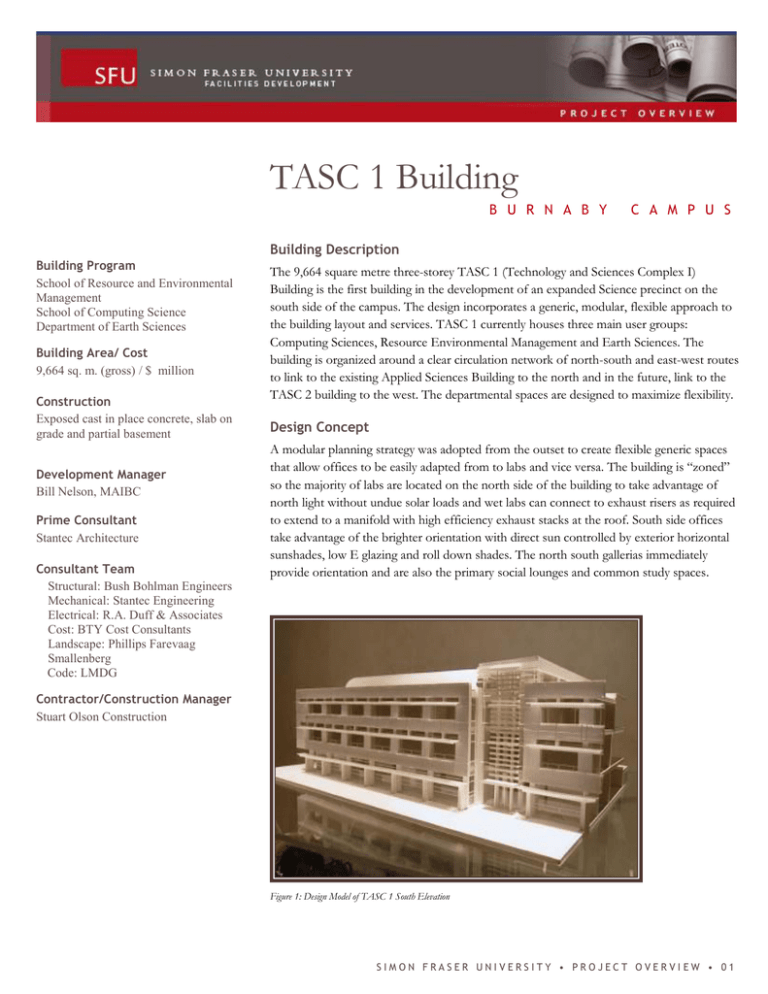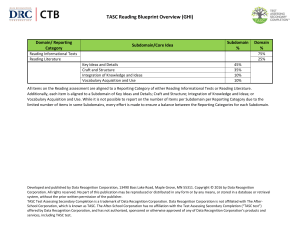TASC 1 Building Building Description
advertisement

TASC 1 Building B U R N A B Y C A M P U S Building Description Building Program School of Resource and Environmental Management School of Computing Science Department of Earth Sciences Building Area/ Cost 9,664 sq. m. (gross) / $ million Construction Exposed cast in place concrete, slab on grade and partial basement Development Manager Bill Nelson, MAIBC Prime Consultant Stantec Architecture Consultant Team Structural: Bush Bohlman Engineers Mechanical: Stantec Engineering Electrical: R.A. Duff & Associates Cost: BTY Cost Consultants Landscape: Phillips Farevaag Smallenberg Code: LMDG The 9,664 square metre three-storey TASC 1 (Technology and Sciences Complex I) Building is the first building in the development of an expanded Science precinct on the south side of the campus. The design incorporates a generic, modular, flexible approach to the building layout and services. TASC 1 currently houses three main user groups: Computing Sciences, Resource Environmental Management and Earth Sciences. The building is organized around a clear circulation network of north-south and east-west routes to link to the existing Applied Sciences Building to the north and in the future, link to the TASC 2 building to the west. The departmental spaces are designed to maximize flexibility. Design Concept A modular planning strategy was adopted from the outset to create flexible generic spaces that allow offices to be easily adapted from to labs and vice versa. The building is “zoned” so the majority of labs are located on the north side of the building to take advantage of north light without undue solar loads and wet labs can connect to exhaust risers as required to extend to a manifold with high efficiency exhaust stacks at the roof. South side offices take advantage of the brighter orientation with direct sun controlled by exterior horizontal sunshades, low E glazing and roll down shades. The north south gallerias immediately provide orientation and are also the primary social lounges and common study spaces. Contractor/Construction Manager Stuart Olson Construction Figure 1: Design Model of TASC 1 South Elevation SIMON FRASER UNIVERSITY • PROJECT OVERVIEW • 01 Building Concepts for Flexibility Energy saving Design Features: Control systems to limit and control cooling and heating requirements Split chillers to allow operational flexibility and operation under partial load conditions Glulam wood beams span across galleria Figure 2: Artist’s rendering of main Entrance Lobby Architectural/Site: Planning based on a framework of modular generic spaces that can be easily modified without disruption Architectural, mechanical, data and electrical systems have been zoned to accommodate access for initial and future installations Locate offices on the south side for brighter orientation, with direct sun controlled by exterior horizontal sunshades, low-E glazing and interior blinds Supplement ventilation and provide occupant temperature control with operable windows along perimeter offices Clerestory windows and light shelves above the shading elements allow daylight to wash across ceilings to reduce the use of artificial lighting Storm water is detained in a landscaped area along the south side of the building. Planting and landscaping will filter some of the fines to provide sedimentation control, important to protect watersheds on the mountain top No irrigation systems through use of native and drought resistant planting Structural: High fly ash concrete used in foundations Simple repetitive structural planning grid for lab module integrated with building services Structure anticipates future floor openings for vertical services. Mechanical: Operable windows are monitored so mechanical control systems minimize energy use when windows are opened Atrium motorized opening windows and ceiling fans assist the mechanical systems during seasonal extremes of hot or cold Controlled flow roof drains to minimize impact on storm systems Metered faucets on wash basins. Electrical: Electrical, data infrastructure designed as “plug and play” to facilitate reconfiguration on a continued basis in laboratories Occupancy sensors control lighting to conserve energy Light sensors automatically shut off atrium lighting when sufficient daylighting is present. SIMON FRASER UNIVERSITY • PROJECT OVERVIEW • 02





